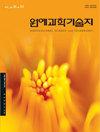不同盐浓度灌溉对开垦地白菜生长、养分吸收特性及硫代葡萄糖苷含量的影响
IF 0.8
4区 农林科学
Q3 HORTICULTURE
Korean Journal of Horticultural Science & Technology
Pub Date : 2021-10-01
DOI:10.7235/HORT.20210051
引用次数: 1
摘要
开垦后的土地土壤中含有大量的可溶性盐和可交换钠,因此有必要选择和培育耐盐作物。大白菜是泡菜的主要成分,是一种重要的蔬菜,占韩国叶菜生产面积的大部分,但目前还没有在开垦的土地上种植大白菜以检测其生长和硫代葡萄糖苷含量的报道。本研究的目的是分析不同盐浓度的灌溉水对春秋季开垦地上种植的大白菜的生长、营养吸收特性和硫代葡萄糖苷含量的影响。灌溉水的盐浓度分别为0、2和4dS∙m-1。春、秋两季白菜的生长不随灌溉水盐分浓度的变化而变化,只有秋两季的白菜Na含量随灌溉水的盐分浓度的增加而增加。随着灌溉水含盐量的增加,硫代葡萄糖苷总含量呈下降趋势。灌溉水中盐分浓度的增加可以减少秋白菜的苦味。结果表明,即使开垦地灌溉水的盐分浓度达到4dS·m-1,也可以种植大白菜,秋季大白菜的硫代葡萄糖苷含量随着盐分浓度的增加而降低。附加关键词:常量营养素、微量营养素、盐胁迫、次生代谢产物、氯化钠本文章由计算机程序翻译,如有差异,请以英文原文为准。
Analysis of Changes in Growth, Nutrient Absorption Characteristics, and Glucosinolate Contents of Chinese Cabbage (Brassica rapa pekinensis) Grown in Reclaimed Land according to Irrigation with Different Salt Concentrations
Reclaimed land contains a large amount of soluble salts and exchangeable sodium in the soil, so it is necessary to select and cultivate tolerant crops that are resistant against salt stress. Chinese cabbage, a staple ingredient in kimchi, is an important vegetable that accounts for most of the production area of leafy vegetables in Korea, but no cases have been reported of growing cabbages in reclaimed land to examine growth and glucosinolate content. The objective of this study was to analyze the growth, nutrient absorption characteristics, and glucosinolate content of Chinese cabbages grown in spring and autumn on reclaimed land with irrigation water with different salt concentrations. The salt concentrations of the irrigation water were 0, 2, and 4 dS∙m -1 . Growth of spring and autumn Chinese cabbages did not change according to the salt concentration of the irrigation water, and only autumn Chinese cabbages showed an increase of Na content according to the salt concentration of the irrigation water. The total glucosinolate content tended to decrease when the salt concentration of irrigation water increased. The increase in salt concentration of irrigation water may reduce the bitterness of autumn Chinese cabbage. Here, it was confirmed that Chinese cabbage cultivation is possible even if the salt concentration of irrigation water reaches 4dS·m -1 on reclaimed land, and the glucosinolate content of autumn Chinese cabbage decreases when salt concentration increases. Additional key words: macronutrient, micronutrient, salt stress, secondary metabolite, sodium chloride
求助全文
通过发布文献求助,成功后即可免费获取论文全文。
去求助
来源期刊
CiteScore
2.00
自引率
0.00%
发文量
0
审稿时长
1 months
期刊介绍:
Horticultural Science and Technology (abbr. Hortic. Sci. Technol., herein ‘HST’; ISSN, 1226-8763), one of the two official journals of the Korean Society for Horticultural Science (KSHS), was launched in 1998 to provides scientific and professional publication on technology and sciences of horticultural area. As an international journal, HST is published in English and Korean, bimonthly on the last day of even number months, and indexed in ‘SCIE’, ‘SCOPUS’ and ‘CABI’. The HST is devoted for the publication of technical and academic papers and review articles on such arears as cultivation physiology, protected horticulture, postharvest technology, genetics and breeding, tissue culture and biotechnology, and other related to vegetables, fruit, ornamental, and herbal plants.

 求助内容:
求助内容: 应助结果提醒方式:
应助结果提醒方式:


